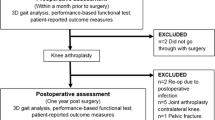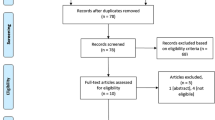Abstract
Background
While some clinical reports suggest minimally invasive surgical (MIS) techniques improve recovery and reduce pain in the first months after TKA, it is unclear whether it improves gait and thigh muscle strength.
Questions/Purposes
We hypothesized TKA performed through a mini-subvastus approach would improve subjective and objective and subjective function compared to a standard medial parapatellar approach 2 months after surgery.
Methods
We randomized 40 patients into two groups using either the mini-subvastus approach or standard medial parapatellar approach. Patients were evaluated preoperatively and 2 months after surgery. We assessed subjective functional outcome and quality of life (QOL) using routine questionnaires (SF-12, Knee Society Score [KSS], Knee Injury and Osteoarthritis Outcome Score [KOOS], UCLA activity, patient milestone diary of activities). We determined isometric strength of the thigh muscles and assessed gait with a three-dimensional (3-D) analysis during level walking and stair climbing.
Results
We observed improvements from preoperatively to 2 months postoperatively in functional scores, QOL, and knee kinematic and kinetic gait parameters during level and stair walking. Isometric quadriceps strength increased in both groups, although remaining lower when compared to sound limbs. We found no differences between the groups in KSS, SF-12, KOOS, UCLA activity, patient milestone diary of activities, isometric quadriceps strength, or 3-D gait parameters, except a marginally higher speed of stair ascent in the MIS group.
Conclusions
Our observations suggest an MIS approach does not confer a substantial advantage in early function after TKA.
Level of Evidence
Level I, therapeutic study. See Instructions to Authors for a complete description of levels of evidence.

Similar content being viewed by others
References
Aglietti P, Baldini A, Giron F, Sensi L. Minimally invasive total knee arthroplasty: is it for everybody? HSS J. 2006;2:22–26.
Alnahdi AH, Zeni JA, Snyder-Mackler L. Gait after unilateral total knee arthroplasty: frontal plane analysis. J Orthop Res. 2011;29:647–652.
Amstutz HC, Thomas BJ, Jinnah R, Kim W, Grogan T, Yale C. Treatment of primary osteoarthritis of the hip: a comparison of total joint and surface replacement arthroplasty. J Bone Joint Surg Am. 1984;66:228–241.
Bade MJ, Kohrt WM, Stevens-Lapsley JE. Outcomes before and after total knee arthroplasty compared to healthy adults. J Orthop Sports Phys Ther. 2010;40:559–566.
Barrack RL, Barnes CL, Burnett RS, Miller D, Clohisy JC, Maloney WJ. Minimal incision surgery as a risk factor for early failure of total knee arthroplasty. J Arthroplasty. 2009;24:489–498.
Boerger TO, Aglietti P, Mondanelli N, Sensi L. Mini-subvastus versus medial parapatellar approach in total knee arthroplasty. Clin Orthop Relat Res. 2005;440:82–87.
Bonutti PM, Zywiel MG, McGrath MS, Mont MA. Surgical techniques for minimally invasive exposures for total knee arthroplasty. Instr Course Lect. 2010;59:83–91.
Bonutti PM, Zywiel MG, Ulrich SD, McGrath MS, Mont MA. Minimally invasive total knee arthroplasty: pitfalls and complications. Am J Orthop. 2010;39:480–484.
Cheng T, Liu T, Zhang G, Peng X, Zhang X. Does minimally invasive surgery improve short-term recovery in total knee arthroplasty? Clin Orthop Relat Res. 2010;468:1635–1648.
Coon TM. Specialized instruments and modular implants for minimally invasive total knee arthroplasty. Am J Orthop. 2006;35:12–17.
Gandhi R, Smith H, Lefaivre KA, Davey JR, Mahomed NN. Complications after minimally invasive total knee arthroplasty as compared with traditional incision techniques: a meta-analysis. J Arthroplasty. 2011;26:29–35.
Growney E, Meglan D, Johnson M, Cahalan T, An KN. Repeated measures of adult normal walking using a video tracking system. Gait Posture. 1997;6:147–162.
Han I, Seong SC, Lee S, Yoo JH, Lee MC. Simultaneous bilateral MIS-TKA results in faster functional recovery. Clin Orthop Relat Res. 2008;466:1449–1453.
Hatfield GL, Hubley-Kozey CL, Astephen Wilson JL, Dunbar MJ. The effect of total knee arthroplasty on knee joint kinematics and kinetics during gait. J Arthroplasty. 2011;26:309–318.
Healy WL, Iorio R, Ko J, Appleby S, Lemos SW. Impact of cost reduction programs on short-term patient outcome and hospital cost of total knee arthroplasty. J Bone Joint Surg Am. 2002;84:348–353.
Insall JN, Dorr LD, Scott RD, Scott WN. Rationale of the Knee Society clinical rating system. Clin Orthop Relat Res. 1989;248:13–14.
Kashyap SN, van Ommeren JW. Clinical experience with less invasive surgery techniques in total knee arthroplasty: a comparative study. Knee Surg Sports Traumatol Arthrosc. 2008;16:544–548.
Kaufman K, Hughes C, Morrey B, Morrey M, An K. Gait characteristics of patients with knee osteoarthritis. J Biomech. 2001;34:907–915.
Kellgren J, Lawrence J. Radiological assessment of osteo-arthritis. Ann Rheumatic Dis. 1957;16:494–502.
Kim YH, Kim JS, Kim DY. Clinical outcome and rate of complications after primary total knee replacement performed with quadriceps-sparing or standard arthrotomy. J Bone Joint Surg Br. 2007;89:467–470.
Krych AJ, Horlocker TT, Hebl JR, Pagnano MW. Contemporary pain management strategies for minimally invasive total knee arthroplasty. Instr Course Lect. 2010;59:99–109.
Kuster MS, Wood GA, Stachowial GW, Gachter A. Joint load considerations in total knee replacements. J Bone Joint Surg Br. 1997;79:109–113.
Leopold SS. Minimally invasive total knee arthroplasty for osteoarthritis. New Eng J Med. 2009;360:1749–1758.
Lombardi AV Jr, Viacava AJ, Berend KR. Rapid recovery protocols and minimally invasive surgery help achieve high knee flexion. Clin Orthop Relat Res. 2006;452:117–122.
Maffiuletti NA, Bizzini M, Widler K, Munzinger U. Asymmetry in quadriceps rate of force development as a functional outcome measure in TKA. Clin Orthop Relat Res. 2010;468:191–198.
Mandeville D, Osternig LR, Chou LS. The effect of total knee replacement on dynamic support of the body during walking and stair ascent. Clin Biomech (Bristol, Avon). 2007;22:787–794.
Mandeville D, Osternig LR, Lantz BA, Mohler CG, Chou LS. The effect of total knee replacement on the knee varus angle and moment during walking and stair ascent. Clin Biomech (Bristol, Avon). 2008;23:1053–1058.
Masson JB. The new demands by patients in the modern era of total joint arthroplasty. Clin Orthop Relat Res. 2008;466:146–152.
Mont MA, Zywiel MG, McGrath MS, Bonutti PM. Scientific evidence for minimally invasive total knee arthroplasty. Instr Course Lect. 2010;59:73–82.
Mundermann A, Dyrby CO, Andriacchi TP. Secondary gait changes in patients with medial compartment knee osteoarthritis: increased load at the ankle, knee, and hip during walking. Arthritis Rheum. 2005;52:2835–2844.
Noble PC, Conditt MA, Cook KF, Mathis KB. The John Insall Award. Patient expectations affect satisfaction with total knee arthroplasty. Clin Orthop Relat Res. 2006;452:35–43.
Pagnano MW, Meneghini RM. Minimally invasive total knee arthroplasty with an optimized subvastus approach. J Arthroplasty. 2006;21:22–26.
Pagnano MW, Meneghini RM, Trousdale RT. Anatomy of the extensor mechanism in reference to quadriceps-sparing TKA. Clin Orthop Relat Res. 2006;452:102–105.
Pan WM, Li XG, Tang TS, Qian ZL, Zhang Q, Zhang CM. Mini-subvastus versus a standard approach in total knee arthroplasty: a prospective, randomized, controlled study. J Int Med Res. 2010;38:890–900.
Purser JL, Weinberger M, Cohen HJ, Pieper CF, Morey MC, Li T, Williams GR, Lapuerta P. Walking speed predicts health status and hospital costs for frail elderly male veterans. J Rehabil Res Dev. 2005;42:535–546.
Ramsey DK, Snyder-Mackler L, Lewek M, Newcomb W, Rudolph KS. Effect of anatomic realignment on muscle function during gait in patients with medial compartment knee osteoarthritis. Arthritis Rheum. 2007;57:389–397.
Redelmeier DA, Bayoumi AM, Goldstein RS, Guyatt GH. Interpreting small differences in functional status: the six minute walk test in chronic lung disease patients. Am J Respir Crit Care Med. 1997;155:1278–1282.
Roos EM, Toksvig-Larsen S. Knee injury and osteoarthritis outcome score (KOOS) —validation and comparison to the WOMAC in total knee replacement. Health Qual Life Outcomes. 2003;1:17.
Rossi R, Maiello A, Bruzzone M, Bonasia DE, Blonna D, Castoldi F. Muscle damage during minimally invasive surgical total knee arthroplasty traditional versus optimized subvastus approach. Knee. 2011;18:254–258.
Schroer WC, Diesfeld PJ, Reedy ME, LeMarr AR. Mini-subvastus approach for total knee arthroplasty. J Arthroplasty. 2008;23:19–25.
Schroer WC, Diesfeld PJ, Reedy ME, LeMarr AR. Isokinetic strength testing of minimally invasive total knee arthroplasty recovery. J Arthroplasty. 2010;25:274–279.
Schulz KF, Altman DG, Moher D. CONSORT 2010 statement: updated guidelines for reporting parallel group randomized trials. Ann Intern Med. 2010;152:726–732.
Simon SR. Quantification of human motion: gait analysis—benefits and limitations to its application to clinical problems. J Biomech. 2004;37:1869–1880.
Smith AJ, Lloyd DG, Wood DJ. A kinematic and kinetic analysis of walking after total knee arthroplasty with and without patellar resurfacing. Clin Biomech (Bristol, Avon). 2006;21:379–386.
Smith TO, King JJ, Hing CB. A meta-analysis of randomized controlled trials comparing the clinical and radiological outcomes following minimally invasive to conventional exposure for total knee arthroplasty. Knee. 2012;19:1–7.
Staehli S, Glatthorn JF, Casartelli N, Maffiuletti NA. Test-retest reliability of quadriceps muscle function outcomes in patients with knee osteoarthritis. J Electromyogr Kinesiol. 2010;20:1058–1065.
Trousdale RT, McGrory BJ, Berry DJ, Becker MW, Harmsen WS. Patients’ concerns prior to undergoing total hip and total knee arthroplasty. Mayo Clin Proc. 1999;74:978–982.
Varela-Engocheaga JR, Suarez-Suarez MA, Fernandez-Villan M, Gonzales-Sastre V, Varela-Gomez JR, Rodriguez-Merchan C. Minimally invasive subvastus approach: improving the results of total arthroplasty: a prospective, randomized trial. Clin Orthop Relat Res. 2010;468:1200–1208.
Ware JE, Kosinski M, Keller SD. A 12-item Short-Form Health Survey: construction of scales and preliminary tests of reliability and validity. Med Care. 1996;34:220–233.
Yu B, Kienbacher T, Growney ES, Johnson ME, An KN. Reproducibility of the kinematics and kinetics of the lower extremity during normal stair-climbing. J Orthop Res. 1997;15:348–352.
Acknowledgments
We thank Mrs. Barbara Iverson for her assistance in manuscript preparation.
Author information
Authors and Affiliations
Corresponding author
Additional information
Each author certifies that he or she, or a member of his or her immediate family, has no commercial associations (eg, consultancies, stock ownership, equity interest, patent/licensing arrangements, etc) that might pose a conflict of interest in connection with the submitted article.
All ICMJE Conflict of Interest Forms for authors and Clinical Orthopaedics and Related Research editors and board members are on file with the publication and can be viewed on request.
Each author certifies that his/her institution has approved the human protocol for this investigation, that all investigations were conducted in conformity with ethical principles of research, and that informed consent for participation in the study was obtained.
About this article
Cite this article
Wegrzyn, J., Parratte, S., Coleman-Wood, K. et al. The John Insall Award: No Benefit of Minimally Invasive TKA on Gait and Strength Outcomes: A Randomized Controlled Trial. Clin Orthop Relat Res 471, 46–55 (2013). https://doi.org/10.1007/s11999-012-2486-1
Published:
Issue Date:
DOI: https://doi.org/10.1007/s11999-012-2486-1




